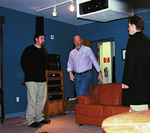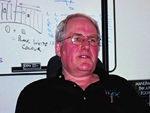Examcollection imparts you confidence by offering an exam success with 100% money back guarantee on all its products such as PT0-002 real Questions and Answers, PT0-002 Lab Exam and PT0-002 VCE Exams. However, if by any hard luck, you do not succeed in the exam, we are ready to refund your money.
Get now: https://www.examcollectionsite.com/PT0-002-exam.html
THX ULTRA: Episode 2 Listening Strikes Back
While it sounds like just a sequel to a successful predecessor, THX Ultra 2 is a substantially different system specification. Audio editor Chris Lewis, associate editor Geoffrey Morrison, and I traveled to Northern California to interview Laurie Fincham, THX's director of engineering and the mastermind behind the new certification program. For those of you who aren't familiar with the Lucasfilm audio-engineering division (yeah, there's this thing called movies; they're a combination of sound and images…), THX was initially founded to set standards for and certify commercial theaters. These standards ensure that the soundtrack played in a certified theater is the same as the one the director heard when he or she mixed the movie on a standardized soundstage. The Home THX program strives to bring this same standard to the home theater environment.
 The initial THX specification, which was later renamed Ultra to make room for the group's smaller-room-based Select specification, was essentially a no-holds-barred approach to bringing the cinema experience home. The system was based mostly on the theoretical capabilities of a theatrical system, combined with the challenging acoustic environment of the typical home theater. The system was optimized for film soundtracks, though, and many critics argued that it didn't sound as good with music. Although THX Ultra, created in the days of Dolby Pro Logic, was designed to accommodate digital soundtrack formats (Dolby Digital and DTS), it didn't take into account the newer EX and ES formats. With the advent and proliferation of high-resolution multichannel-music formats and the acceptance of digital 5.1 and EX movie soundtracks, it became obvious that the old guard needed to be updated for the new generation.
The initial THX specification, which was later renamed Ultra to make room for the group's smaller-room-based Select specification, was essentially a no-holds-barred approach to bringing the cinema experience home. The system was based mostly on the theoretical capabilities of a theatrical system, combined with the challenging acoustic environment of the typical home theater. The system was optimized for film soundtracks, though, and many critics argued that it didn't sound as good with music. Although THX Ultra, created in the days of Dolby Pro Logic, was designed to accommodate digital soundtrack formats (Dolby Digital and DTS), it didn't take into account the newer EX and ES formats. With the advent and proliferation of high-resolution multichannel-music formats and the acceptance of digital 5.1 and EX movie soundtracks, it became obvious that the old guard needed to be updated for the new generation.
 Before he broke the system down into its complementary parts, Laurie explained that some of Ultra 2's additional goals were "to perform at its best with both movies and music with one speaker layout and be less room-dependent." THX Ultra front loudspeakers, for example, were originally optimized for movie soundtracks and were required to have focused vertical directivity. This radiation pattern prevents sound from spraying up toward the ceiling or down toward the floor, which might cause audible colorations, thus providing clean dialogue and clear sound effects. Unfortunately, the vertical D'Appolito driver array that most manufacturers employ to meet this specification tends to create a less-than-smooth vertical off-axis frequency response. In the last decade or two, considerable research and listening experiments have shown that a smooth off- and on-axis frequency response is important to a system's sound quality. The Ultra specification works great for movie soundtracks and can sound good with music played in an acoustically treated high-end home theater where the uneven off-axis response can be absorbed, but it is often criticized with music playback in the more-lively living rooms that the speakers were intended for. While THX's ideal goal is still to limit undesirable early reflections, they have laid the responsibility for achieving it in the hands of the consumer. THX Ultra 2's front-speaker specification places a greater premium on having a "well-defined, smoothly varying frequency response both on- and off-axis," which guarantees that both music and movies will sound good in both dedicated theater rooms and general-purpose living areas.
Before he broke the system down into its complementary parts, Laurie explained that some of Ultra 2's additional goals were "to perform at its best with both movies and music with one speaker layout and be less room-dependent." THX Ultra front loudspeakers, for example, were originally optimized for movie soundtracks and were required to have focused vertical directivity. This radiation pattern prevents sound from spraying up toward the ceiling or down toward the floor, which might cause audible colorations, thus providing clean dialogue and clear sound effects. Unfortunately, the vertical D'Appolito driver array that most manufacturers employ to meet this specification tends to create a less-than-smooth vertical off-axis frequency response. In the last decade or two, considerable research and listening experiments have shown that a smooth off- and on-axis frequency response is important to a system's sound quality. The Ultra specification works great for movie soundtracks and can sound good with music played in an acoustically treated high-end home theater where the uneven off-axis response can be absorbed, but it is often criticized with music playback in the more-lively living rooms that the speakers were intended for. While THX's ideal goal is still to limit undesirable early reflections, they have laid the responsibility for achieving it in the hands of the consumer. THX Ultra 2's front-speaker specification places a greater premium on having a "well-defined, smoothly varying frequency response both on- and off-axis," which guarantees that both music and movies will sound good in both dedicated theater rooms and general-purpose living areas.
 Furthermore, because of the proliferation of the LFE (low-frequency-effects) channel in digital 5.1 soundtracks, THX recognized a need for a tougher subwoofer specification. THX Ultra certification only required a sub to extend to 35 hertz, for example. At the time, Dolby Stereo had trouble supporting much information below that, and a phenomenon called room gain tends to boost output at low frequencies anyway. The extended low-frequency-output capabilities of a 5.1 soundtrack's LFE channel and most listeners' general preference for more low bass have prompted THX to require that Ultra 2 subwoofers have a flat frequency response down to 20 Hz, with much greater output and far less distortion. This will undoubtedly result in either larger, more-complex or just multiple THX-approved subwoofers.
Furthermore, because of the proliferation of the LFE (low-frequency-effects) channel in digital 5.1 soundtracks, THX recognized a need for a tougher subwoofer specification. THX Ultra certification only required a sub to extend to 35 hertz, for example. At the time, Dolby Stereo had trouble supporting much information below that, and a phenomenon called room gain tends to boost output at low frequencies anyway. The extended low-frequency-output capabilities of a 5.1 soundtrack's LFE channel and most listeners' general preference for more low bass have prompted THX to require that Ultra 2 subwoofers have a flat frequency response down to 20 Hz, with much greater output and far less distortion. This will undoubtedly result in either larger, more-complex or just multiple THX-approved subwoofers.
 Additional speaker specifications ensure that the system has sufficient output capabilities without distortion and that the subwoofer and main speakers blend well. To determine distortion limits, THX spent a significant amount of time with program material to determine the real peak and continuous demands of movie soundtracks. Using the results of this data, they came up with realistic tests that would ensure that speakers and subwoofers could play at "maximum replay levels" without distortion. These same tests are applied to Ultra 2 amplifiers with all channels driven, as well. Likewise, THX looked at and refined the frequency-response-rolloff slopes for the main speakers. While previous specifications required a certain amount of attenuation at a certain frequency, not much attention was paid to the response below that frequency. Now certification requires a smooth rolloff down to inaudible levels, thus providing a predictable system response.
Additional speaker specifications ensure that the system has sufficient output capabilities without distortion and that the subwoofer and main speakers blend well. To determine distortion limits, THX spent a significant amount of time with program material to determine the real peak and continuous demands of movie soundtracks. Using the results of this data, they came up with realistic tests that would ensure that speakers and subwoofers could play at "maximum replay levels" without distortion. These same tests are applied to Ultra 2 amplifiers with all channels driven, as well. Likewise, THX looked at and refined the frequency-response-rolloff slopes for the main speakers. While previous specifications required a certain amount of attenuation at a certain frequency, not much attention was paid to the response below that frequency. Now certification requires a smooth rolloff down to inaudible levels, thus providing a predictable system response.
- Log in or register to post comments


Great insights on sound systems! The tips are practical and really enhance the listening experience. Check out : https://www.gl-recycling.com/

Visuals: Describe the layout and artwork on the page. Mention any key visual elements, such as characters, settings, and notable artistic techniques.
Text: Summarize the dialogue or text on the page. Highlight any important conversations or narrative developments and Compact Living .

Thank you for your insights ! If you’re looking for a way to get your press release in front of the right audience, our free distribution service might be just what you need. We help businesses of all sizes expand their reach by distributing news to top media outlets and journalists. It’s quick, easy, and completely free to get started. Let me know if you'd like more details!

Great post! Thanks for sharing your Thoughts. If you want to Learn, Online Course Geeks is the premier online class help service, offering top-notch support to students who want to achieve their best in their online classes. Whether you need help with you online classes our professional tutors have got you covered.




















































